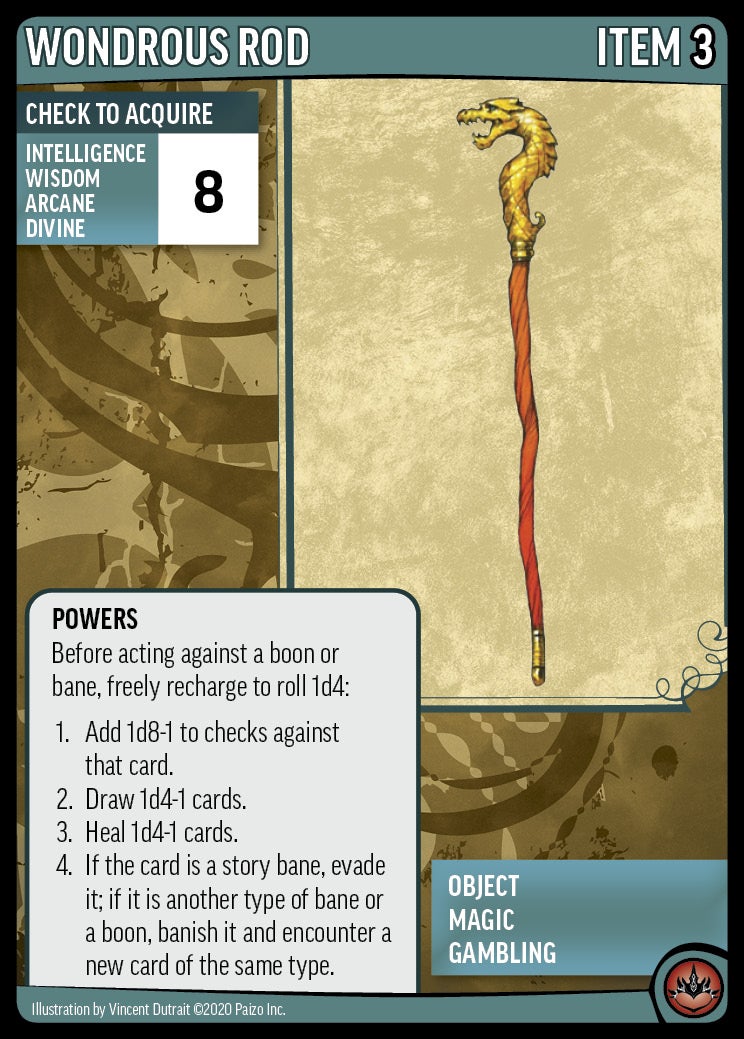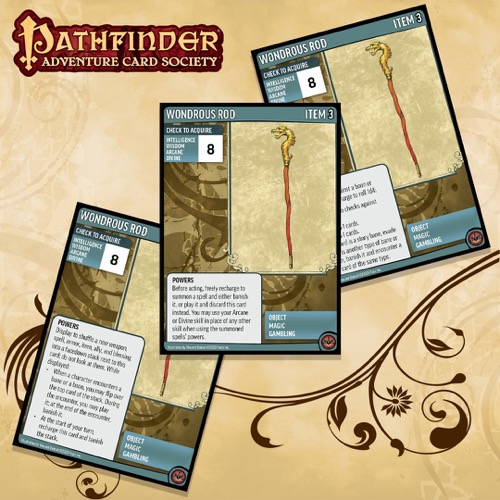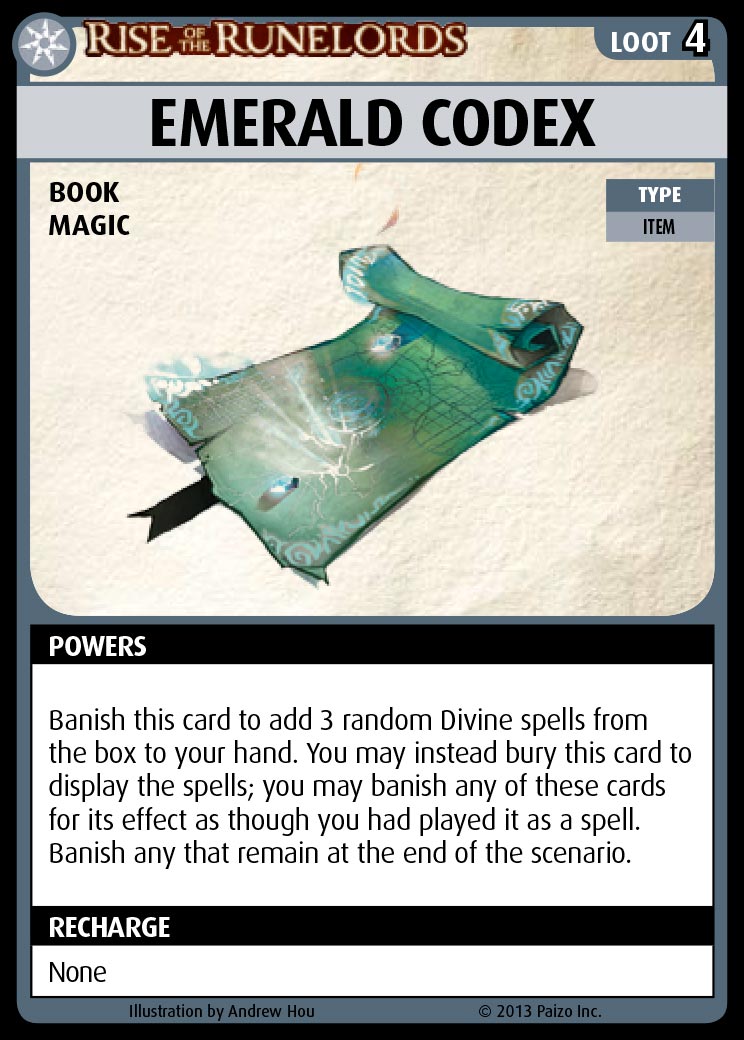Today’s Pathfinder Adventure Card Game blog is brought to you by Keith Richmond (text in blue) and Chad Brown (text in brown, of course!), with some additional text by Vic Wertz (in your browser’s standard text color).
Not the most wondrous of rods, but he’s definitely got the random part down.
PACG Cutting Room Floor: Wondrous Rod
Friday, October 23, 2020
In the RPG version of the Curse of the Crimson Throne Adventure Path, Pilts Swastel, the insane, self-proclaimed Emperor of Old Korvosa, carries a Rod of Wonder. We’re told that “each time he successfully uses the device, he shrieks in delight and offers impromptu commentary on the rod’s results.”
When filling out our boon lists for the PACG version of Curse of the Crimson Throne, Rod of Wonder was added fairly early on as a possible level 3 boon. We eventually renamed it Wondrous Rod to avoid running afoul of the SRD-OGL police. We even more eventually cut it to the floor, forgotten until now.
While card count is the ultimate reason it was cut, another reason it was cut is because Chad and I could never agree on its design. Two cards enter, no cards leave. Or maybe a few cards eventually leave. Let’s find out.
Before we get to the Curse version, though, I actually tried to build a version as potential Loot for Rise of the Runelords, but it got cut pretty quickly. As I recall, it functioned somewhat like a random version of RotR’s Emerald Codex, but with more words. I recall that it had most of the downsides we later disliked in the Curse versions included here, and Mike was pretty sure that Vic would prefer to stab me with a pen rather than try to fit it onto a card.

Keith’s original Crimson Throne version.
The first Curse version generated one of four random effects.
(An aside: I looked hard for a way to replicate the RPG effect that boils down to “target is encased in a 10-foot cube of lime Jell-O.” The functionality is in there with “evade the card,” but it lacks a certain... flavor.)
At this point, Keith and I were working together, but on different coasts, so my playtest groups (hello, awesome playtesters!) were somewhat separated from Keith’s (hello, other awesome playtesters!). While we talk frequently, and we use the playtest forums to coordinate multiple groups (hello, other other awesome playtesters!), sometimes small changes can get missed. In this case, early feedback from out west suggested that it felt weird for the item to be nearly always beneficial.
Let’s talk about upside/downside effects for a minute. In general, PACG abstracts a whole raft of actions down into a (relatively!) simple resolution method. In a typical Pathfinder RPG combat encounter, you might easily make dozens of decisions about your actions. In PACG, though, it just feels terrible to try something unpredictable and get something non-functional—something much closer to “we failed a fight” than “it took an extra round.” If we want these sorts of unpredictable effects in the game—and we know that many people enjoy them—we have to be careful about the costs.
Because PACG characters can carry a limited number of boons in their hands and decks, I feel fairly strongly that it had to measure up to the quality of other comparable boons. So let’s break down what it does.
¼ of the time, it adds 1d8-1 to your checks against the card. Undeniably good ⅞ of the time, ⅛ of the time a waste of a card.
¼ of the time, you draw 1d4-1 cards. Risky if you’re down to only a few cards or your turn is about to end. Helpful for this encounter... occasionally. Let’s call this arguably good ¾ of the time, though truly beneficial maybe only ⅜ of the time, ¼ of the time a waste of a card.
¼ of the time, you heal 1d4-1 cards. Note there’s no “may,” so that can screw up other things you might be doing like recharging cards in some order or avoiding drawing something you don’t want to. Still, arguably good ¾ of the time, but almost never beneficial for this encounter, and ¼ of the time a waste of a card.
¼ of the time, you get a new encounter. Or evade a story bane, which might make you reluctant to use the card at all against a story bane you think you can defeat. Let’s call that ¼ good, ¼ neutral, ¼ bad, and ¼ a waste of a card.
Obviously, all of that math is super handwavy, but I add it up as roughly 15/32 good, 8/32 neutral, 2/32 bad, and 7/32 waste of a card. Looks random enough to me, even if it won’t occasionally turn you or your target permanently blue. And if you’re into Gambling, the thrill of the unknown itself might just make it all upside for you.
At some point fairly early on, Keith’s original version got changed. I’m not sure exactly when; I had to dig way back into the document history to find his original version. Something like half a year earlier, it had been replaced with the version that we eventually decided to cut from the set:

The last version before it was cut.
Obviously, this wanted to be a Gambling item. We wanted it to be at least somewhat unpredictable. We also wanted it to feel at least potentially better for magic-wielding types than for (say) drunken chaos lovers (and lovers of chaos); that’s why it let you use Arcane or Divine to “make it work”—this let us cross the Arcane/Divine streams, so to speak.
Earlier wordings of this card were built as a wand, and thus used the bury/recovery concept, but the rod can be used at-will, which saved us some text on an already-wordy card. We settled on “freely recharge” to get you a cheap-and-easy look at the effect, and “discard instead” to give it a reasonable cost if you kept the effect. Had it survived, we probably would have considered ways to get it back into your deck even if you kept the summoned spell effect.
Generating a semi-random effect without potentially locking you out of the encounter proved to be complicated to write out, especially around the timing: you need to use the card very early, since the rules mandate that “setting the type of check” comes first. This led us to start with “before acting.” We also didn’t want the card to be “floating around” for any longer than necessary, since that can lead to scary and/or confusing special cases—witness the variety of ways that “display” effects end. In particular, we wanted to make sure that you couldn’t keep the spell (something that is right for the Emerald Codex but wrong for the Rod of Wonder). The concept was clear, though, and that’s good enough for playtesting, especially early on, where it’s likely that Keith or I are present.
Unfortunately, that last version has a couple major flaws. There’s a timing issue, where you want to summon a spell early in the encounter then play it at some later point in the encounter. As written, you can’t use, say, Force Missile, since you can’t play it for your combat check while you’re still “before acting.” Also, a random summoned spell is really random. Your chance of getting something helpful dwindles very rapidly, especially for non-caster characters. Vic also notes that the wording wants “summon and banish” to be a thing, but the game’s rules don’t actually cover that. Obviously, if we hadn’t cut it, we’d have tried to address those flaws. But, since I liked my version better, I just left a note to do that, left the alternate version in our sheet, and moved on with life. And when it came time to put together the final card list, we already had more than we needed without this one.
Let’s pretend we hadn’t had card count issues, though, and think about addressing the playtesters' complaints.
In order to make the “summon a spell” bit work better, we need to clarify that you summon the spell early in the encounter, and just have to use it sometime before the end of the encounter. Ideally, from my perspective, we also don’t weight it entirely towards casters by just treating your Arcane or Divine as something solid like 1d12+5 for this card. Even more ideally, we make it less randomly useless by reducing the cost of using it (perhaps it reloads) or by increasing the chance it’s useful (draw more than 1 spell). Or summon something other than spells. Chad has some other ideas there...
We definitely get into opinions here, but… my take on the upside/downside tradeoff is that the card should sometimes do good (or even great) stuff, and if it doesn’t, it’s usually enough for the downside to be “opportunity cost”—that is, you put the card in your deck, got it into your hand, didn’t discard it for damage or feed it to a saltbox/character power/location close, and then chose to play it. In that world, if it doesn’t help you, at least it didn’t also hurt you. The key to this is that it can’t stop you from doing whatever else you might have available. This makes it a fun card to try out even when you have other options, and if you find yourself with your back against a wall, maybe you’ll get lucky.
This led us to the following version, a rough recreation of an idea that we were spitting back and forth before we decided to cut the card and focus our efforts elsewhere:
Display this card, and secretly make a pile of 5 new boons of your choice under it. While displayed, you may reveal a random card from the pile, then you may freely recharge or freely reload this card to use that boon's effect. Then, return the revealed boon to the box.
This idea evolved from a random boon concept—initially, 1 new boon from a fixed list. “Weapon, armor, spell, and item” felt reasonable, but since the rod was doing the work, it made sense storywise (to me, anyway) for it to allow summoning a temporary ally, and from there, you might as well also put blessings on the table. Like the previous “summon a spell” version, it felt like an intuitive way to phrase a mostly random effect. Letting you choose the types of boons gave you some agency, but not knowing what they were until the last moment still felt (I theorize) unpredictable. It also leaned into the new concept in the Core Set and Curse of the Crimson Throne> that your vault would contain higher-level boons—back in the RotR days, the most you could hope for is to get that shiny new card of your current adventure deck number (or, as we call it now, “#”), but here you might actually drop that Meteor Swarm a couple levels early. Delicious.
Unfortunately, there are some problems with this version, as Keith wisely points out:
That version, of course, has not been developed—at all. Let’s go behind the curtain for a second on doing that.
“New boons of your choice” is likely to cause confusion, so it’d probably want to be “types of your choice”.
The timing of when you can use it is still a bit up in the air. Nothing seems to be limiting you from looking at the cards when not in an encounter.
Combine those two problems together, and you’ve encouraged people to choose 5 allies or blessings and use them for explores. Every round. Eep!
So, let’s take a stab at a revision:
Display. Secretly shuffle a new weapon, spell, armor, item, ally, and blessing into a facedown pile next to this card.
- When a bane or boon is encountered, you may flip the top card of the pile. During the encounter, you may summon and play the flipped card. At the end of the encounter or after it is summoned, banish the flipped card.
- At the start of your turn, recharge this card and banish the pile.
Okay, now it’s time for some editing. Unless there’s a good reason, cards begin “[action you take to play the card] to [effect that happens immediately on playing].” And displayed cards use the words “while displayed” to separate effects that happen immediately from effects that you can play later. Also, “secretly” is not a game term—I know the designers want it to mean that nobody should know what the new cards are, but it could be misconstrued to mean that the person assembling the pile can know but should keep it “secret” from the other players. (That really wouldn’t be a very PACG thing for the designers to do, but we still need to cut off that possibility.) It’s clear that the designers also intended for “secret” to block the rule that allows you to look at your displayed cards, but that needs to be more explicit. Next, we use the word “pile” for faceup groupings of cards that can be looked at and (usually) reordered at will, and “stack” for facedown groupings of cards that (usually) may not be looked at or reordered. The phrasing “When a bane or boon is encountered” is unnecessarily passive, and also makes it easy to miss that you can flip a card from the stack on someone else’s encounter. Finally, the word “summon” is backed with a lot of rules, and most of them shouldn’t apply here—most notably, summoning a card that’s already in play creates a copy of it that ceases to exist when it’s no longer needed without affecting the original, and that’s really not what they want to happen here. It also caused the unnecessary complication with “at the end of the encounter or after it is summoned”—all that really matters is that the card ends up banished regardless of where it ended up during the encounter, and that’s easily said. So:
There are probably still some holes here, but I think at this point we’ve got a couple playable versions. Of course, we never really did a full playtest of them. So, have at it, folks. And let us know how it goes.
Keith Richmond
PACG Designer
Chad Brown
PACG Designer
Vic Wertz
PACG Editor







